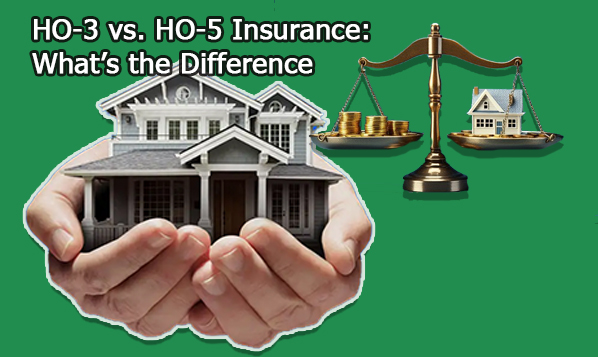HO-3 vs. HO-5 insurance policies are forms of home insurance but understanding what’s the difference might seem beneficial. These forms of home insurance provide financial coverage against damages to your home, other structures on your property, personal belongings, and liability coverage. HO-3 insurance offers open peril for your home and other structures with the option to include additional coverage through endorsement.

Meanwhile, HO-5 insurance offers additional coverage for personal property, while providing the same coverage as dwelling and other structure coverage. This article will explain the advantages and disadvantages of HO-3 vs. HO-5 insurance and what’s the difference between them. Doing this will help you choose the right policy for your house.
What is HO-3 Insurance
HO-3 insurance policies are the most universally applicable and regarded as the minimal permissible coverage when applying for a mortgage. Generally, there are five coverage in HO-3 insurance including A, B, C, D, and E.
Coverage A
This includes any attached buildings, such as a garage, deck, or porch, as well as the actual building in which you reside. Typically, your house is covered against open hazards.
Coverage B
This includes any other structures on your land that are not connected to your house, such as tennis courts, sheds, detached garages, and fences. You can choose to have these structures insured for more than the standard 10% of your Coverage A amount.
Coverage C
This covers your home’s contents, including its furniture, appliances, and other personal belongings. Your contents are insured against named perils, which are explicitly mentioned in the policy, not open perils, which cover your home, and are not covered if not listed.
Coverage D
This coverage, also known as “loss of use” coverage, kicks in if your house becomes uninhabitable. It pays for any additional living expenses as well as the cost of lodging in a hotel. Furthermore, this coverage is named peril-based and is 10% of the Coverage A amount or limited to a specific period.
Coverage E
This is your policy’s personal liability section, which protects you if you are held legally liable for harm done to another person or their property. It usually pays for any court expenses or legal fees related to compensating you for any damages.
What is HO-5 Insurance
Compared to other forms of house insurance, HO-5 insurance provides more comprehensive coverage. This policy, also known as a comprehensive policy, provides “open perils” coverage for your home, detached structures, and personal property. Homeowners’ insurance policies cover any potential damage caused by any cause, unless it explicitly excludes the cause as an exclusion.
What Does HO-5 Insurance Cover
The same fundamental coverage categories are included in both HO-3 and HO-5 insurance. HO-5 policies cover various aspects like home, detached buildings, personal belongings, third-party medical expenses, personal liability, and loss of use. HO-5 insurance policies offer payouts based on the replacement cost of personal property and are open perils policies.
What Does HO-3 vs. HO-5 Insurance Not Cover
Both HO-3 and HO-5 policies offer open peril dwelling coverage, safeguarding your home from various risks. However, certain risks are excluded from coverage under a HO-3 or HO-5 policy and will be noted as such in your coverage documents.
These exclusions may differ between insurance companies, among policies, and even based on the home’s location. Among the hazards that are frequently excluded are floods, tornadoes, earthquakes, mold damage, sewer backups, landslides, and more. Furthermore, repairs and damages associated with normal wear and tear are always excluded from homeowners’ insurance coverage.
To cover your house against some of these risks, you might still be able to purchase separate coverage, but it will cost more. Your options for coverage may be restricted and expensive if you live in an area that is vulnerable to specifically excluded perils. These include areas like coastal towns that are vulnerable to hurricanes or a known floodplain.
HO-3 vs. HO-5 Insurance: What’s the Difference
The most popular kind of homeowners insurance is HO-3 coverage. Your dwelling, or the building that makes up your home, is covered by both HO-3 vs. HO-5 policies on an open perils basis. However, what’s the difference between HO-3 vs. HO-5 insurance?
HO-3 and HO-5 differ in the coverage of personal property due to the unique policy forms. Your possessions are covered against named perils under an HO-3 policy, but they are covered against open perils under an HO-5 policy. This implies that anything beyond the perils explicitly mentioned in the policy is deemed excluded and your personal property is only protected against those risks.
Which Is Better Between HO-3 vs. HO-5 Insurance
Generally, HO-5 home insurance policies are more extensive than HO-3 policies. Numerous HO-3 restrictions are eliminated, current coverage is expanded upon, and completely new coverage is added. Meanwhile, HO5 policies offer more peace of mind at a comparable cost and are priced roughly in the same range as HO-3s.
An HO-5 home insurance policy might be appropriate for you if you have many high-value items in your home, live in a safe neighborhood, or simply wish to close some coverage gaps.

